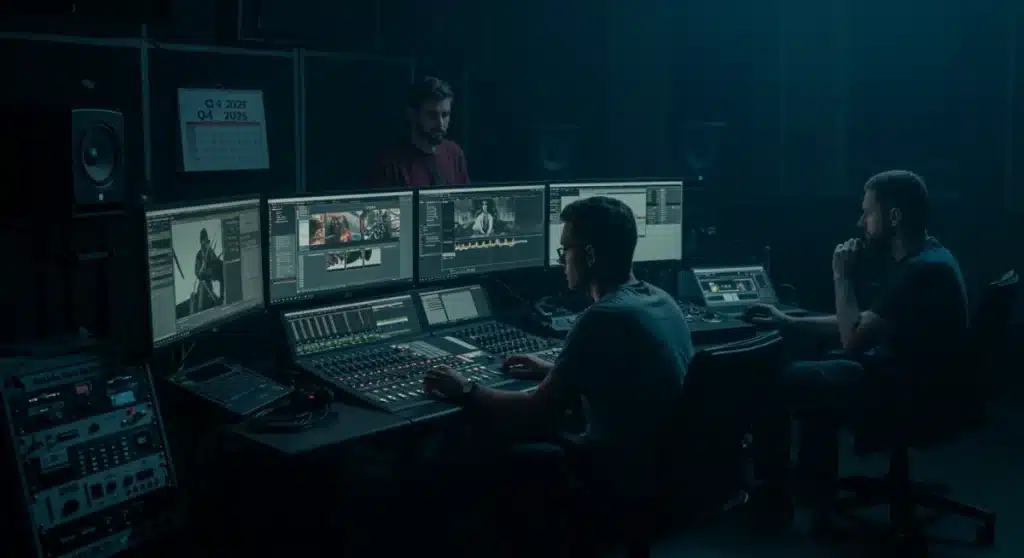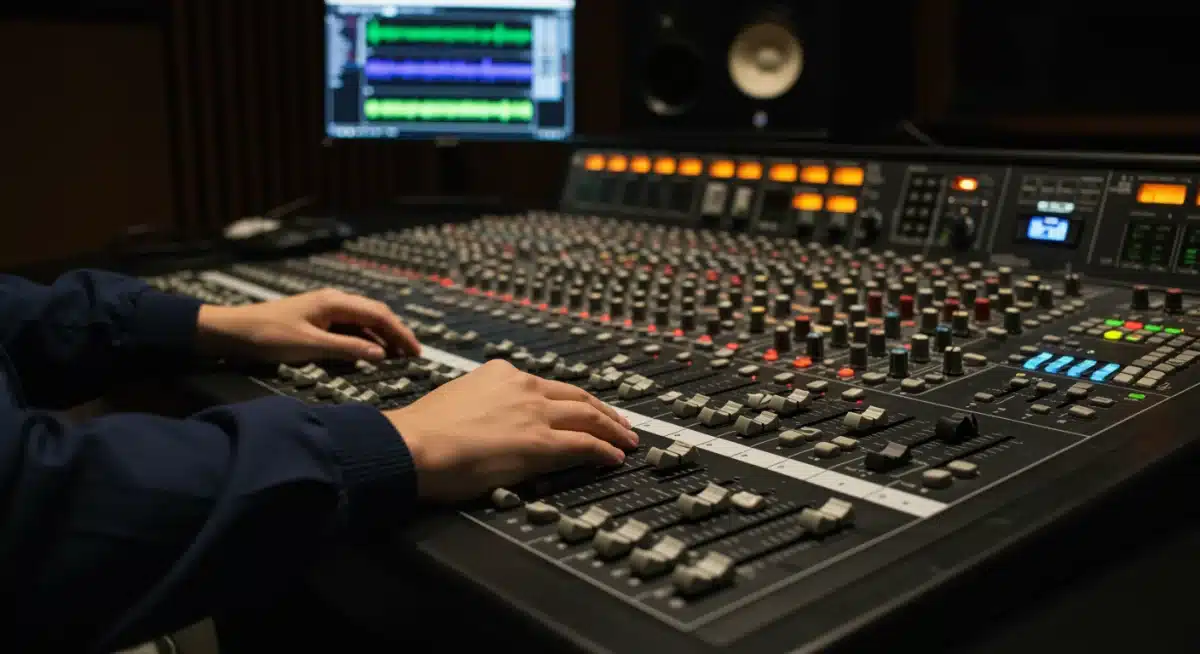Post-Production Pipeline: 9 Steps for Feature Film Delivery

The post-production pipeline for a feature film involves nine critical steps, including editing, sound design, visual effects, and final mastering, all essential for successful delivery by the targeted year-end 2025 deadline.
Understanding the Post-Production Pipeline: 9 Essential Steps for a Feature Film’s Final Delivery by Year-End 2025 is paramount for filmmakers aiming for a successful release. The journey from raw footage to a polished cinematic experience is complex, demanding meticulous planning and execution across various specialized departments.
The Initial Assembly: Editorial and Offline Edit
The post-production process begins immediately after principal photography wraps, with the editorial team taking center stage. This crucial phase involves organizing all recorded footage, selecting the best takes, and assembling them into a coherent narrative. The goal is to craft the story’s emotional arc and pacing before any visual or audio enhancements are applied.
As of recent developments, AI-assisted editing tools are increasingly being integrated to streamline the initial assembly, helping editors quickly sort through vast amounts of footage. This technology, while still developing, promises to accelerate the offline edit phase significantly, allowing more time for creative refinement.
Organizing Raw Footage
Before any cutting begins, all raw footage must be ingested, logged, and organized. This foundational step ensures that editors can efficiently locate specific shots and takes, preventing costly delays down the line.
- Data Management: Securely backing up all media files to prevent data loss.
- Logging: Cataloging each take with detailed notes on performance, technical quality, and director’s comments.
- Bin Structure: Creating a logical folder system within editing software for easy navigation.
Crafting the First Cut
The first cut, often called the assembly edit, is where the story truly starts to take shape. Editors work closely with the director to translate the script into a visual narrative, making initial decisions on scene order, pacing, and basic transitions. This stage is iterative, involving multiple revisions based on feedback.
Picture Lock: Committing to the Narrative
Picture lock is a pivotal moment in the post-production pipeline, marking the point where no further changes will be made to the film’s visual sequence. Once picture lock is achieved, the edited timeline is handed off to other departments, such as sound, visual effects (VFX), and color grading, to begin their specialized work. Any changes after this point can incur significant costs and delays.
Recent reports from major studios indicate a growing trend towards earlier picture lock dates for films targeting late 2025 delivery. This proactive approach aims to provide ample time for complex VFX sequences and detailed sound design, which often require extensive lead times.
Review and Approval Process
Achieving picture lock involves a rigorous review and approval process. The director, producers, and sometimes key stakeholders like studio executives, watch multiple cuts of the film. Their feedback is crucial in refining the narrative structure, character development, and overall storytelling.
- Director’s Cut: The director’s preferred version of the film.
- Producer’s Cut: Incorporating producer feedback for marketability and audience appeal.
- Studio Approval: Final sign-off from the studio, ensuring alignment with project goals.
This collaborative effort ensures that the final locked picture is the best possible version of the story, ready for the subsequent technical enhancements that will bring it to life on screen.
Sound Design and Mixing: The Auditory Landscape
Sound design and mixing are critical components of the post-production pipeline, elevating the emotional impact and immersive quality of a film. This stage involves creating, enhancing, and balancing all auditory elements, including dialogue, sound effects, Foley, and musical score. A well-crafted soundscape can significantly influence audience perception and engagement.
Industry experts are emphasizing the importance of spatial audio technologies, such as Dolby Atmos, for upcoming 2025 releases. These advancements allow for a more three-dimensional sound experience, demanding specialized mixing techniques and equipment to fully realize their potential.
Building the Soundscape
The sound design process begins by layering various audio elements to build a rich and believable world. This includes cleaning up dialogue, adding ambient sounds, and creating specific sound effects that underscore actions or emotions.
- Dialogue Editing: Ensuring clarity and consistency of all spoken lines, removing unwanted noise.
- Foley: Recording custom sound effects, like footsteps or prop movements, synchronized to picture.
- Sound Effects (SFX): Sourcing or creating effects to enhance action, atmosphere, and mood.

The Art of Audio Mixing
Once all sound elements are in place, the mixing engineer balances their levels, panning, and equalization to create a cohesive and dynamic audio track. This phase is crucial for ensuring that no single element overpowers another and that the overall sound serves the narrative effectively. The final mix is often tailored for different exhibition formats, including theatrical, home video, and streaming.
Visual Effects (VFX): Bringing the Impossible to Life
Visual effects (VFX) are often the most time-consuming and technically demanding aspect of the post-production pipeline, especially for films with fantastical elements or complex set pieces. This department is responsible for creating, enhancing, or altering visual imagery through digital means, ranging from subtle clean-ups to elaborate computer-generated imagery (CGI).
With 2025 delivery targets, VFX studios are leveraging advanced machine learning algorithms to expedite rendering times and improve realism. Recent reports highlight breakthroughs in AI-driven facial animation and crowd simulation, allowing for unprecedented detail and efficiency in complex shots.
Planning and Pre-visualization
VFX work doesn’t just start after picture lock; extensive planning and pre-visualization often occur during pre-production and production. Storyboards, animatics, and previs help to define the scope and complexity of VFX shots, ensuring that on-set filming captures the necessary elements for seamless integration.
- Concept Art: Developing visual ideas for creatures, environments, and effects.
- Pre-visualization (Previs): Creating rough animated versions of complex scenes to plan camera angles and timing.
- On-set Supervision: VFX supervisors ensure that footage is captured correctly for post-production integration.
Execution and Integration
The execution phase involves multiple specialized artists working on different aspects of a shot, from modeling and texturing to animation, lighting, and compositing. Each element is meticulously crafted and then integrated into the live-action footage, often requiring several iterations to achieve photorealism and artistic intent.
Color Grading: Shaping the Film’s Visual Tone
Color grading is a critical artistic and technical step in the post-production pipeline that profoundly impacts a film’s aesthetic and emotional resonance. This process involves adjusting and enhancing the color, contrast, and brightness of every shot to establish a consistent visual tone, evoke specific moods, and guide the audience’s eye. It can transform raw footage into a cinematic masterpiece.
Recent industry discussions emphasize the increasing demand for High Dynamic Range (HDR) grading for films aiming for 2025 delivery, particularly for streaming platforms. HDR offers a wider range of colors and greater contrast, requiring specialized monitors and grading suites to achieve optimal results, as well as a more nuanced approach to color decisions.
Establishing the Look
The colorist works closely with the director and cinematographer to define the film’s overall look and feel. This involves creating a ‘look book’ or reference images that serve as a guide for the grading process. Decisions are made on everything from color palettes to specific stylistic choices for different scenes or character arcs.
- Primary Corrections: Adjusting global exposure, contrast, and white balance across scenes.
- Secondary Corrections: Isolating specific colors or areas of the image for targeted adjustments.
- Matching Shots: Ensuring seamless color continuity between different takes and scenes.
Creative Enhancement and Finalization
Beyond technical corrections, color grading is a creative process of enhancement. It can be used to emphasize certain elements, soften others, or even subtly alter the perception of time or location. The final graded images are then rendered, preparing the film for the subsequent stages of mastering and delivery. This stage is crucial for translating the director’s vision into a polished visual experience that captivates audiences.
Mastering and Deliverables: Ready for Exhibition
The final stages of the post-production pipeline involve mastering and creating deliverables, which are the various formats required for exhibition and distribution. This highly technical phase ensures that the film meets the stringent specifications for theatrical release, streaming platforms, broadcast, and home video. Precision and attention to detail are paramount to avoid rejection during quality control.
With the 2025 deadline approaching, studios are increasingly prioritizing IMF (Interoperable Master Format) as the preferred delivery format due to its efficiency in managing multiple versions (languages, subtitles, accessibility features) from a single master. This streamlines the global distribution process significantly.
Creating the Digital Cinema Package (DCP)
For theatrical release, the film must be converted into a Digital Cinema Package (DCP). This encrypted file format contains all the audio, video, and subtitle elements, ensuring high-quality projection in cinemas worldwide. The creation of a DCP involves specific encoding, encryption, and quality control checks.
- Encoding: Converting the final master file into the JPEG 2000 format for video and uncompressed WAV for audio.
- Encryption: Protecting the content with security keys for controlled distribution to theaters.
- Key Delivery Message (KDM): Generating unique keys for each theater and playback window.
Preparing for Other Platforms
Beyond theatrical, films require various other deliverables tailored for different platforms. This includes specific aspect ratios, audio mixes, subtitle tracks, and compression standards for streaming services (e.g., Netflix, Amazon Prime Video), broadcast television, and Blu-ray/DVD. Each platform has its own set of technical specifications that must be rigorously adhered to.
The meticulous preparation of these diverse deliverables ensures that the film can reach the widest possible audience in the highest possible quality, making this a critical final hurdle in the journey from concept to screen.
| Key Stage | Brief Description |
|---|---|
| Editorial & Offline Edit | Organizing footage and crafting the initial narrative structure. |
| Picture Lock | Finalizing the visual sequence before handing off to other departments. |
| Sound Design & Mixing | Creating and balancing all auditory elements for immersive experience. |
| Mastering & Deliverables | Converting the film into various formats for exhibition and distribution. |
Frequently Asked Questions About Film Post-Production
While all steps are vital, ‘Picture Lock’ is arguably the most critical. It freezes the edit, allowing other specialized departments like VFX and sound to proceed without costly rework, ensuring a streamlined workflow towards final delivery.
The duration varies significantly based on film complexity, especially VFX. It can range from 3-6 months for smaller productions to over a year for large-scale blockbusters, with meticulous planning required for a 2025 delivery.
AI is increasingly used for tasks like initial footage sorting, automated rotoscoping, facial animation, and even optimizing rendering processes in VFX. It accelerates workflows and enhances realism, contributing to more efficient project completion.
Color grading unifies the film’s visual aesthetic, establishes mood, and guides audience perception. It ensures consistency across all shots, corrects technical imperfections, and enhances the storytelling by shaping the emotional impact of the visuals.
Deliverables are the final film masters and assets formatted for various distribution channels (theaters, streaming, broadcast). They are crucial because each platform has unique technical specifications that must be met for the film to be exhibited correctly and widely.
What Happens Next
As the film industry continues to evolve, the post-production pipeline for feature films targeting year-end 2025 delivery will see further integration of AI and cloud-based collaborative tools. These advancements are set to redefine traditional workflows, pushing for greater efficiency and creative freedom. Producers and post-production supervisors will need to stay abreast of these technological shifts to remain competitive and ensure timely, high-quality releases. The emphasis on global distribution formats like IMF will also grow, streamlining the complex process of bringing films to international audiences.